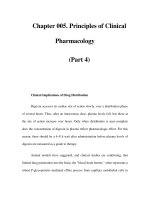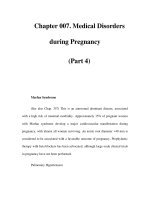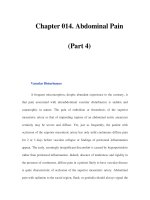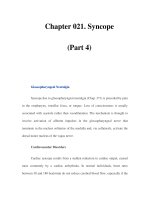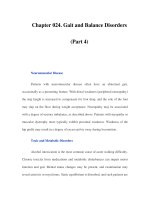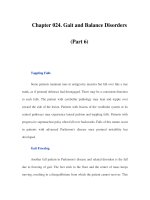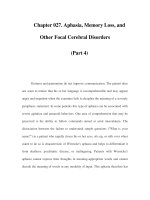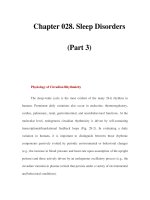Chapter 028. Sleep Disorders (Part 4) ppsx
Bạn đang xem bản rút gọn của tài liệu. Xem và tải ngay bản đầy đủ của tài liệu tại đây (11.3 KB, 5 trang )
Chapter 028. Sleep Disorders
(Part 4)
Behavioral Correlates of Sleep States and Stages
Polysomnographic staging of sleep correlates with behavioral changes
during specific states and stages. During the transitional state between
wakefulness and sleep (stage 1 sleep), subjects may respond to faint auditory or
visual signals without "awakening."
Memory incorporation is inhibited at the onset of NREM stage 1 sleep,
which may explain why individuals aroused from that transitional sleep stage
frequently deny having been asleep.
Such transitions may intrude upon behavioral wakefulness after sleep
deprivation, notwithstanding attempts to remain continuously awake (see "Shift-
Work Disorder," below).
Awakenings from REM sleep are associated with recall of vivid dream
imagery >80% of the time. The reliability of dream recall increases with REM
sleep episodes occurring later in the night. Imagery may also be reported after
NREM sleep interruptions, though these typically lack the detail and vividness of
REM sleep dreams.
The incidence of NREM sleep dream recall can be increased by selective
REM sleep deprivation, suggesting that REM sleep and dreaming per se are not
inexorably linked.
Physiologic Correlates of Sleep States and Stages
All major physiologic systems are influenced by sleep. Changes in
cardiovascular function include a decrease in blood pressure and heart rate during
NREM and particularly during slow-wave sleep.
During REM sleep, phasic activity (bursts of eye movements) is associated
with variability in both blood pressure and heart rate mediated principally by the
vagus.
Cardiac dysrhythmias may occur selectively during REM sleep.
Respiratory function also changes. In comparison to relaxed wakefulness,
respiratory rate becomes more regular during NREM sleep (especially slow-wave
sleep) and tonic REM sleep and becomes very irregular during phasic REM sleep.
Minute ventilation decreases in NREM sleep out of proportion to the
decrease in metabolic rate at sleep onset, resulting in a higher P
CO2
.
Endocrine function also varies with sleep. Slow-wave sleep is associated
with secretion of growth hormone, while sleep in general is associated with
augmented secretion of prolactin.
Sleep has a complex effect on the secretion of luteinizing hormone (LH):
during puberty, sleep is associated with increased LH secretion, whereas sleep in
the postpubertal female inhibits LH secretion in the early follicular phase of the
menstrual cycle.
Sleep onset (and probably slow-wave sleep) is associated with inhibition of
thyroid-stimulating hormone and of the adrenocorticotropic hormone–cortisol
axis, an effect that is superimposed on the prominent circadian rhythms in the two
systems.
The pineal hormone melatonin is secreted predominantly at night in both
day- and night-active species, reflecting the direct modulation of pineal activity by
the circadian pacemaker through a circuitous neural pathway from the SCN to the
pineal gland.
Melatonin secretion is not dependent upon the occurrence of sleep,
persisting in individuals kept awake at night. In addition, exogenous melatonin
increases sleepiness and increases sleep duration when administered to healthy
adults attempting to sleep during daylight hours, at a time when endogenous
melatonin levels are low.
The efficacy of melatonin as a sleep-promoting therapy for patients with
insomnia is currently not known.
Sleep is also accompanied by alterations of thermoregulatory function.
NREM sleep is associated with an attenuation of thermoregulatory responses to
either heat or cold stress, and animal studies of thermosensitive neurons in the
hypothalamus document an NREM-sleep-dependent reduction of the
thermoregulatory set-point.
REM sleep is associated with complete absence of thermoregulatory
responsiveness, effectively resulting in functional poikilothermy. However, the
potential adverse impact of this failure of thermoregulation is blunted by inhibition
of REM sleep by extreme ambient temperatures.
